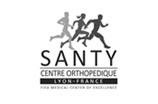Elbow Arthroscopy
What is Elbow Arthroscopy?
Elbow arthroscopy, also referred to as keyhole or minimally invasive surgery, is performed through tiny incisions to evaluate and treat several elbow conditions.
Elbow Anatomy
The elbow is a complex hinge joint formed by the articulation of three bones - humerus, radius and ulna. The upper arm bone or humerus connects the shoulder to the elbow forming the upper portion of the hinge joint. The lower arm consists of two bones, the radius and the ulna. These bones connect the wrist to the elbow forming the lower portion of the hinge joint.
The three joints of the elbow are:
- Ulnohumeral joint, the junction between the ulna and humerus
- Radiohumeral joint, the junction between the radius and humerus
- Proximal radioulnar joint, the junction between the radius and ulna
The elbow is held in place with the support of various soft tissues including cartilage, tendons, ligaments, muscles, nerves, blood vessels and bursae.
Indications of Elbow Arthroscopy
Elbow arthroscopy has been used to manage loose bodies, symptomatic plicae, osteochondral defects (OCD), lateral epicondylitis and elbow contractures. Its utilization in the treatment of elbow contractures has increased in recent years due to distinct advantages compared to open procedures. In addition to the lower morbidity from less soft tissue dissection, arthroscopy allows uncompromised visualization of the complex elbow articulation. The primary indications for arthroscopic capsular release in the setting of elbow stiffness are osteoarthritis, posttraumatic contracture and rheumatoid arthritis.
OSTEOARTHRITIS
Osteoarthritis of the elbow is characterized by relative joint space preservation, the presence of loose bodies, capsular contracture and hypertrophic osteophyte formation. Patients present clinically with restricted range of motion and pain at the extremes of motion secondary to impingement on osteophytes. Capsular contracture develops subsequent to loss of motion. Surgical indications for the management of the osteoarthritic elbow include functional limitation, painful stiffness and mechanical symptoms. Patients must have failed nonoperative managment. Whether the approach is open or arthroscopic, the primary goals of surgical management in the osteoarthritic elbow are excision of impinging osteophytes, release of the contracted capsule and removal of loose bodies.1 Ulnohumeral arthroplasty has been used to describe this comprehensive approach to open joint debridement with satisfactory results in the long-term.2,3
Improvement in pain and range of motion has been reported with arthroscopic debridement and capsular release of the osteoarthritic elbow. Cohen et al. reported more improvement in pain than range of motion with arthroscopic debridement and olecrenon fossa fenestration in twenty-six patients at mean follow-up of 35.3 months.4 Ogilvie-Harris et al. managed twenty-one patients who had elbow osteoarthritis and posterior impingement with arthroscopic debridement, removal of loose bodies, and osteophyte excision of the olecranon and olecrenon fossa.5 Fourteen patients achieved excellent and seven achieved good results at a mean follow-up of 35 months. Savoie et al. showed decreased pain and improvement in total range of motion of 81 degrees after arthroscopic synovectomy, osteophyte excision and olecrenon fossa fenestration in twenty-four patients.6 Radial head excision was performed in eighteen of the twenty-four patients in this series.
RHEUMATOID ARTHRITIS
Pathologic deterioration in the rheumatoid elbow results from synovitis, capsular contracture, symmetric joint space destruction, periarticular erosions and late bony deformity. Indications for arthroscopic intervention include functional limitation, synovitis, contracture, pain refractory to disease modification or age that precludes consideration for total elbow arthroplasty. Ideal candidates for minimally invasive surgical intervention should demonstrate radiographic preservation of cartilage and have no major bony deformity.7 Arthroscopic intervention for the rheumatoid elbow includes synovectomy, osteophyte excision and capsular release.
There has been controversy with regard to the longevity of both open as well as arthroscopic synovectomy in the rheumatoid patient.7-11 Arthroscopy may result in less complete synovectomy as compared to the open approach.7 Despite this skepticism, several studies have demonstrated pain relief from arthroscopic synovectomy. Nemoto et al. reported pain relief and improved function in ten patients who underwent arthroscopic synovectomy at mean follow-up of 37 months.12 Horiuchi et al. showed that improved outcome with arthroscopic synovectomy has been associated with elbows that have remaining cartilage and less deformity.13 In their series, arthroscopic synovectomy resulted in better improvement when the patient was managed with disease modification. This underscores the importance of concomitant medical management of the systemic arthritis.
POSTTRAUMATIC CONTRACTURE
Loss of motion of the elbow may result from capsular contracture, intraarticular adhesions, loose bodies, impinging osteophytes or articular incongruity following fracture or dislocation. Indications for arthroscopic management of contracture include limitation of activities of daily living and painful stiffness. Surgical candidates must have failed nonoperative measures such as aggressive therapy and static or dynamic splinting. Patients must also demonstrate willingness to comply with postoperative rehabilitation.
Arthroscopic capsular release of posttraumatic elbow contracture results in improved range of motion and outcome. Phillips and Strasburger reported the results of twenty-five patients who underwent arthroscopic release of an elbow contracture.14 The contracture was posttraumatic in fifteen patients, and these improved in total arc of motion from 80 degrees preoperatively to 130 degrees postoperatively. Kim and Shin reported improvement in elbow range of motion from 73 to 123 degrees in fifteen patients who underwent arthroscopic treatment of posttraumatic elbow arthrofibrosis.15 The patients in the studies by Kim and Phillips had a more severe preoperative restriction in motion with a posttraumatic as opposed to an arthritic etiology, but no significant difference in the total postoperative arc of motion between the groups postoperatively. Ball et al. reported an improved arc of motion from 82 to 124 degrees in fourteen patients who underwent arthroscopic capsular release.16 The postoperative functional score from the American Shoulder and Elbow Surgeons Elbow Assessment Form was 28.3 out of 30, and all patients reported that they would undergo the surgery again.
- O’Driscoll SW. Arthroscopic treatment for osteoarthritis of the elbow. Orthop Clin 1995, 26(4), 691-706.
- Antuna SA, Morrey BF, Adams RA, et al. Ulnohumeral arthroplasty for primary degenerative arthritis of the elbow: long-term outcome and complications. J Bone Joint Surg Am 2002, 84(12), 2168-2173.
- Phillips NJ, Ali A, Stanley D. Treatment of primary degenerative arthritis of the elbow by ulnohumeral arthroplasty. A long-term follow-up. J Bone Joint Surg Br 2003, 85(3), 347-50.
- Cohen AP, Redden JF, Stanley D. Treatment of osteoarthritis of the elbow: a comparison of open and arthroscopic debridement. Arthroscopy 2000, 16(7), 701-7.
- Ogilvie-Harris DJ, Gordon R, et al. Arthroscopic treatment for posterior impingement in degenerative arthritis of the elbow. Arthroscopy 1995, 11(4), 437-43.
- Savoie FH 3rd, Nunley PD, Field LD. Arthroscopic management of the arthritic elbow: indications, technique, and results. J Shoulder Elbow Surg 1999, 8(3), 214-9.
- Lee BP, Morrey BF. Arthroscopic synovectomy of the elbow for rheumatoid arthritis. A prospective study. J Bone Joint Surg Br 1997, 79(5), 770-2.
- Gendi NS, Axon JM, Carr AJ, et al. Synovectomy of the elbow and radial head excision in rheumatoid arthritis. Predictive factors and long-term outcome. J Bone Joint Surg Br 1997, 79(6), 918-23.
- Lonner JH, Stuchin SA. Synovectomy, radial head excision, and anterior capsular release in stage III inflammatory arthritis of the elbow. J Hand Surg Am 1997, 22(2), 279-85.
- Maenpaa HM, Kuusela PP, Kaarela K, et al. Reoperation rate after elbow synovectomy in rheumatoid arthritis. J Shoulder Elbow Surg 2003, 12(5), 480-3.
- Tulp NJ, Winia WP. Synovectomy of the elbow in rheumatoid arthritis. Long-term results. J Bone Joint Surg Br 1989, 71(4), 664-6.
- Nemoto K, Arino H, Yoshihara Y, et al. Arthroscopic synovectomy for the rheumatoid elbow: a short-term outcome. J Shoulder Elbow Surg 2004, 13(6), 652-5.
- Horiuchi K, Momohara S, Tomatsu T, et al. Arthroscopic synovectomy of the elbow in rheumatoid arthritis. J Bone Joint Surg Am 2002, 84(3), 342-7.
- Phillips BB, Strasburger S. Arthroscopic treatment of arthrofibrosis of the elbow joint. Arthroscopy 1998, 14(1), 38-44.
- Kim SJ, Shin SJ. Arthroscopic treatment for limitation of motion of the elbow. Clin Orthop Rel Res 2000, 375, 140-8.
- Ball CM, Meunier M, Galatz LM, et al. Arthroscopic treatment of post-traumatic elbow contracture. J Shoulder Elbow Surg 2002, 11(6), 624-9.
Evaluation and Diagnosis
Your surgeon will review your medical history and perform a complete physical examination. Diagnostic studies may also be ordered such as X-rays, MRI or CT scan to assist in diagnosis.
Elbow Arthroscopy Procedure
Arthroscopy is a surgical procedure in which an arthroscope, a small soft flexible tube with a light and video camera at the end, is inserted into a joint to evaluate and treat a variety of conditions.
Elbow arthroscopy is commonly performed under general anesthesia as an outpatient procedure. The patient is placed in a lateral or prone position which allows the surgeon to easily adjust the arthroscope and have a clear view of the inside of the elbow.
Several tiny incisions are made to insert the arthroscope and small surgical instruments into the joint. To enhance the clarity of the elbow structures through the arthroscope, your surgeon will fill the elbow joint with a sterile liquid.
The liquid flows through the arthroscope to maintain clarity and to restrict any bleeding. The camera attached to the arthroscope displays the internal structures of the elbow on the monitor and helps your surgeon to evaluate the joint and direct the surgical instruments to fix the problem.
At the end of the procedure, the surgical incisions are closed by sutures, and a soft sterile dressing is applied. Your surgeon will place a cast or a splint to restrict the movement of the elbow.
Advantages of Elbow Arthroscopy
The advantages of arthroscopy compared to traditional open elbow surgery include:
- Smaller incisions
- Minimal soft tissue trauma
- Less post-operative pain
- Faster healing time
- Lower infection rate
Rehabilitation & Postoperative Care
Postoperative care for patients after arthroscopic osteocapsular arthroplasty is focused on minimizing elbow swelling, infection prophylaxis and preservation of motion gains achieved during surgery. All patients are splinted for 24 hours in extension for edema control and pain relief. Soft dressings are applied under the splint and are left intact after splint removal allowing motion exercises but maintaining a sterile environment until the initial postoperative visit at 1 – 2 weeks.
Patients begin a home physical therapy program after the anterior extension splint is removed on the second postoperative day. Active assisted elbow flexion/extension and forearm supination/pronation exercises are performed several times per day. Activities of daily living are encouraged. If motion loss occurs within the first 2 to 3 weeks, it is possible to perform a gentle manipulation under anesthesia to release any early adhesions.
Physical therapy is not routinely prescribed for patients after arthroscopic treatment of elbow arthritis if a patient is doing well with home exercises. If limitations in motion and strength are recognized, a formal therapy program is instituted usually at 3 to 6 weeks postoperatively. Also, static progressive splinting may be utilized in the setting of motion loss after surgery. Finally, we have rarely utilized continuous passive motion after arthroscopic release in the setting of a primary arthroscopic procedure. In patients who have already failed a release and require further surgery, continuous passive motion has been prescribed starting immediately postoperative. There is little evidence confirming whether therapy versus splinting versus continuous passive motion provides better maintenance of motion.
Complications of Elbow Arthroscopy
The possible complications following elbow arthroscopy include infection, bleeding, and damage to nerves or blood vessels.





